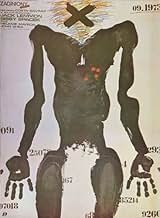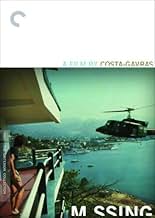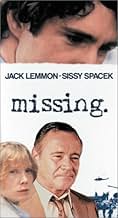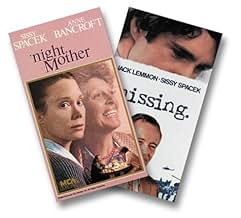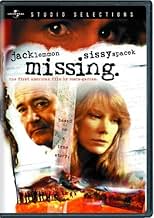Lorsqu'un écrivain américain idéaliste disparaît lors du coup d'État chilien de septembre 1973, sa femme et son père tentent de le retrouver.Lorsqu'un écrivain américain idéaliste disparaît lors du coup d'État chilien de septembre 1973, sa femme et son père tentent de le retrouver.Lorsqu'un écrivain américain idéaliste disparaît lors du coup d'État chilien de septembre 1973, sa femme et son père tentent de le retrouver.
- Réalisation
- Scénario
- Casting principal
- Récompensé par 1 Oscar
- 12 victoires et 23 nominations au total
- Paris
- (as Martin Lasalle)
Avis à la une
The film itself remains a gripping eyeopener from first to last. Costa-Gravas is especially good at recreating the abject terror of fascist rule: where long hair is forbidden and women are forced back into skirts, where people are present one minute and gone the next, where a democratically elected government is present one minute and gone the next, and where a Henry Kissinger can do the behind-the-scenes dirty work and be honored for it (not in the movie, but true nevertheless). The acting is first-rate, and a tour-de-force for Lemmon in particular. Ditto, the often overlooked Charles Cioffi who puts the real chill in the confrontation scene. Two complaints: the arch symbolism of the riderless white horse conflicts with Costa-Gravas's documentary approach, and why, oh why, did they have to make Horman's son so cuddly. The audience gets the point without spooning on the sugar. Anyhow, this remains a fine piece of revelatory film-making and retains as much relevancy for today's audience as it did twenty years ago.
In his American works,while continuing his militant way,Costa-Gavras puts men and women made of flesh and blood on the screen:Jack Lemmon,who made us laugh so many times in Billy Wilder's masterpieces("some like it hot" "kiss me stupid" "the apartment",the highly underrated "Avanti"),shines in his dramatic part;his portrayal of an all-American man,proud of his country,who cannot really understand the evolution of the new generations but who knows that he's got only one son,whom he might never see again,is mind-boggling:his tired and sad face,always seeming on the verge of tears ,mainly in the second half of the movie which contains two classic scenes:
-The first one takes place in the stadium,where the prisoners are gathered;he's given a mike ,but a lump comes to his throat and he hands it to Sissi Spacek -who plays (with talent) the missing son's wife -;In the giant stadium,no echoes ,even when Lemmon,in a desperate call,asks his son to come home.
-The second one takes place in some kind of morgue,where dead bodies pile up.The wife and the father really go to hell,in this almost unbearable scene.
The Putsch (Costa-Gavras takes the American intervention for granted whereas there's nothing that proves it)takes a back seat to the desperate couple's plight.
Costa-Gavras has not completely forsaken France though:the book Spacek and Shea are reading is none other than Saint-Exupery's "le petit prince".
Adapted by Costa-Gavras and Donald Stewart from Thomas Hauser's non-fiction book documenting the true case, the plot focuses on American expatriate Charles Horman whose sudden disappearance in the days after the Pinochet coup brings together two familial adversaries, his wife Beth and his father Ed, who has flown in from New York. Charles and Beth had been leading a vagabond existence with his work in children's animation and their relatively passive support of Allende's reform measures. Charles' back story is revealed in carefully constructed flashback episodes that show him to be curious about the presence of U.S. military personnel in the area. Once he disappears, Ed and Beth seek help from the U.S. Consulate but face a seemingly insurmountable wall of bureaucracy. Frustrated, Ed, a highly conservative Christian Scientist, lashes out at Beth for what he considers her undesirable influence over his son. However, as they absorb the scope of the violence and the culpability of the U.S. government, they bond intractably toward their objective of finding Charles.
For once, Jack Lemmon, unafraid to convey his character's prejudices, is able to use his neurotically coiled energy in a suitable dramatic role as Ed. The result is a startlingly raw performance that ranks among his best. Sissy Spacek is terrific as Beth, though her character does not experience as big an arc of self-revelation. In the elliptical flashback role of Charles, John Shea provides solid support, as do Janice Rule as a political activist and a number of familiar TV faces - Melanie Mayron as friend Terry and David Clennon as U.S. consul Phil Putnam, both from "thirtysomething", and Joe Regalbuto, Frank from "Murphy Brown", playing another Frank, a possible victim of the coup. There are unfortunately no extras with the 2004 DVD.
Jack Lemmon gives another standout performance (in a career that had many) as the uptight father that learns to accept his son only after his suspected death. The emotional evolution from devout christian/disapproving dad to grieving father with 'opened eyes' is engaging to watch. Sissy Spacek shows the strength that should have won her a second oscar 2001 for "In The Bedroom" as the wife who never stops looking for her husband. But the clear winner in this politcal thriller is the director Costa Gravas, who constantly keeps the politcal tension high, without upstaging the performances of the leads.
A great drama that deal with life/death and the bond between parents and their children.
Le saviez-vous
- AnecdotesDuring the Pinochet dictatorship, which ran from 1973 to 1990, this picture was banned in Chile.
- GaffesWhen Ed Horman is at the State Department trying to get information about Charlie, there is the presidential portrait of Richard Nixon on the wall in the background and a more personal photo of him on Marine One on the credenza behind the desk. That photograph, with fingers in the V-peace sign, was taken upon his final departure from the White House in 1974 and could not have been on someone's desk in 1973.
- Citations
Consul Phil Putnam: Please try to understand. There are so many cases. They're all so important, and this isn't the only one we're working on.
Ed Horman: It's the only one I care about.
Consul Phil Putnam: You and a lot of other people. Listen, I've never seen so many cables from Washington. What kind of pull do you have up there anyway?
Ed Horman: I'm an American citizen.
- Bandes originalesMy Ding a Ling
(1952)
Written by Chuck Berry (uncredited)
Performed by Chuck Berry
Courtesy of All Platinum Records, Inc.
Meilleurs choix
Détails
- Date de sortie
- Pays d’origine
- Langues
- Aussi connu sous le nom de
- Desaparecido
- Lieux de tournage
- Acapulco, Guerrero, Mexique(as Vina del Mar)
- Sociétés de production
- Voir plus de crédits d'entreprise sur IMDbPro
Box-office
- Budget
- 9 500 000 $US (estimé)
- Montant brut aux États-Unis et au Canada
- 14 000 000 $US
- Montant brut mondial
- 14 000 000 $US
- Durée2 heures 2 minutes
- Couleur
- Rapport de forme
- 1.85 : 1
Contribuer à cette page



